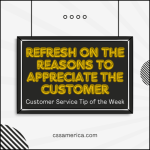Will the government be getting into healthcare with the proposed healthcare reform legislation? That’s probably not the best question to ask, because the government is already in healthcare in many ways. I’m sure we’re all familiar with Medicare and Medicaid, but since this is a customer service and retention-related blog, have you heard of HCAHPS?
The government is already in healthcare in the customer service/satisfaction aspect of the business. The federal government has required that hospitals survey patients using standardized tools to gauge satisfaction with multiple areas of the patient experience including communication, responsiveness, information provided, processes, etc. Then this information is posted on the internet for any current or prospective patient to review to compare one hospital to another.
What if this approach related to other organizations? What if two retail stores had their customer satisfaction ratings posted side-by-side? Or maybe you could compare all restaurants in your region in an evaluation – side-by-side – of key characteristics of the food, the environment, the price, the customer service. How about comparing 3 banks or 4 car dealerships or 5 animal hospitals or 6 grocery stores?
If you were one of those retailers or restaurants or banks or grocery stores being objectively compared for all your current or prospective customers to see, how would you do?
It’s a scary proposition, but if you’re not willing to consider it, believe me, your customers make this evaluation every day.
Think of this as the HCAHPS test. How would you objectively compare on key characteristics of the customer experience with your competitors? If you have no idea, then you might want to consider mystery shopping, having a research firm such as ours to shop your organization…and your competitors.
Make sure you know how you measure up.
Interested in improving your company’s customer service? See more information at: http://www.cssamerica.com/





















